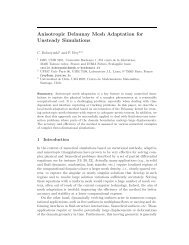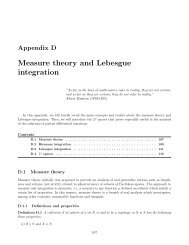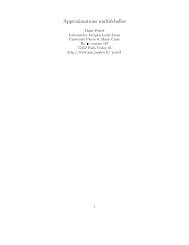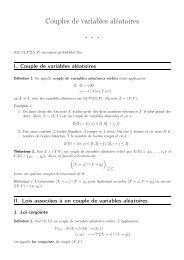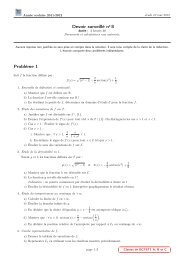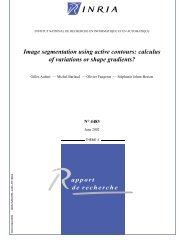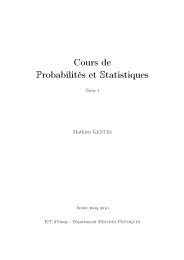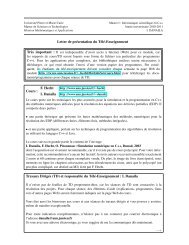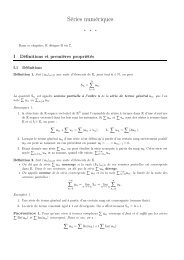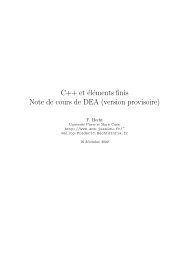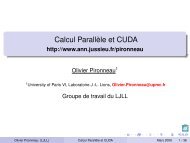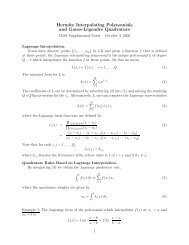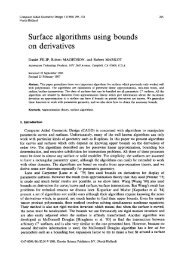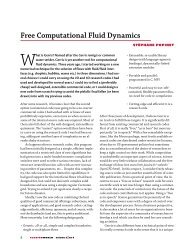pdf file
pdf file
pdf file
You also want an ePaper? Increase the reach of your titles
YUMPU automatically turns print PDFs into web optimized ePapers that Google loves.
28 M. LEWIN, P. T. NAM, S. SERFATY, AND J. P. SOLOVEJ<br />
Proof of Corollary 16. It suffices to show the statement for Φ ′ = Φ. Note<br />
that the quadraticform domain of H is thesame as that of dΓ(h+1) because<br />
of (16), and dΓ(h + 1) preserves all the subspaces Hm +’s. Therefore, if we<br />
denote by ΦM the projection of Φ onto F ≤M<br />
+ , then<br />
lim<br />
M→∞ 〈H〉ΦM = 〈H〉Φ and lim<br />
M→∞ lim 〈H+C〉ΦN−ΦM = 0.<br />
N→∞<br />
If we denote � HN := UN(HN − N eH)U∗ N , then from Proposition 15 we<br />
have<br />
lim<br />
M→∞ 〈� HN −H〉ΦM<br />
= 0 and lim<br />
M→∞ lim<br />
N→∞ 〈� HN〉ΦN−ΦM<br />
= 0.<br />
The latter convergence still holds true with � HN replaced by a non-negative<br />
operator H ′ N := � HN+C0(H+C0), where C0 > 0 is chosen large enough. By<br />
using the Cauchy-Schwarz inequality for the operator H ′ N , we deduce that<br />
lim<br />
M→∞ lim<br />
N→∞ 〈� HN〉Φ −〈 � HN〉ΦM<br />
= 0.<br />
We then can conclude that 〈 � HN〉Φ → 〈H〉Φ as N → ∞. �<br />
The rest of the section is devoted to the proof of Proposition 15. We shall<br />
need the following technical result.<br />
Lemma 17. If (A1)-(A2) hold true, then we have the operator inequalities<br />
on F+:<br />
dΓ(QTQ) ≤<br />
dΓ(Q(|u0| 2 ∗|w|)Q) ≤<br />
1<br />
H+CN+ +C,<br />
1−α1<br />
α2<br />
H+CN+ +C,<br />
1−α1<br />
where 1 > α1 > 0 and α2 > 0 are given in the relative bound (5) in Assumption<br />
(A1).<br />
Proof. Using (5) we get |u0| 2 ∗w ≥ −α1(T +C) and |u0| 2 ∗|w| ≤ α2(T +C).<br />
Consequently, T ≤ (1 − α1) −1 h + C and |u0| 2 ∗ |w| ≤ α2(1 − α1) −1 h + C.<br />
The desired estimates follows from the lower bound H ≥ dΓ(h)−CN+−C<br />
(see Remark 10). �<br />
Now we give the<br />
Proof of Proposition 15. Let Φ be a normalized vector in the quadratic form<br />
domain of H such that Φ ∈ F ≤M<br />
+ for some 1 ≤ M ≤ N. Starting from<br />
the identity (44), we shall compare 〈A2〉Φ with 〈H〉Φ, and show that the<br />
remaining part is negligible.<br />
Step 1. Main part of the Hamiltonian.<br />
Lemma 18 (Bound on A2 −H). We have<br />
� �<br />
� �<br />
�〈A2〉Φ −〈H〉Φ�<br />
≤ M<br />
� �<br />
α2<br />
〈H〉Φ +C〈N+ +1〉Φ .<br />
N −1 1−α1



